
|   |

|   |
 e-mail: leelakaverivenkat@gmail.com Khajuraho Festival - A mishmash of varying levels of proficiency March 13, 2021 The week long (Feb 20-26) Khajuraho Festival 2021, experienced virtually by this critic, seemed to attract moderate to larger audiences braving Covid 19. A rich, holistic cultural event, with many other attractions planned round the main performances, the marathon festival was however a bit of a let -down in terms of artiste selection. It left one wondering about the criteria prompting the choice of dancers - projecting the established with the less good, sometimes bordering on still evolving raw talent. 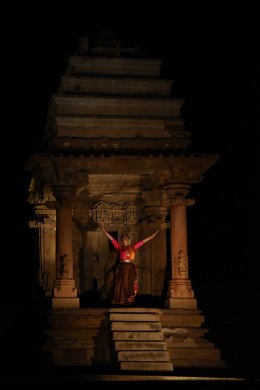 Geeta Chandran 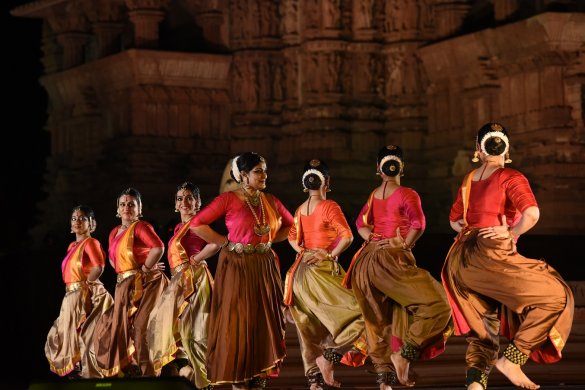 Natya Vriksha ensemble The large stage, at audience level, between the Khandariya Mahadev and Jagadambi temples, seemed suited to group presentations, which were generally of a standard. Following rather prolonged inaugural formalities, came the curtain raiser presentation in Bharatanatyam by Geeta Chandran and her troupe from Natya Vriksha. Titled Anekanta or multiple realities, the idea culled from Jain philosophy (with help from Sudhamahi Raghunathan, author of a book on the subject), expands on its mool mantra emphasizing many versions of each truth, rather than any one cardinal approach looking at every aspect of life. This celebration of multiplicity, very intelligently envisioned, through the medium of stylised Bharatanatyam movement by Geeta Chandran, began with the Alarippu, the traditional beginning to a solo Bharatanatyam margam. Late Sivakumar's brilliant rhythmic variations, knit into the matrix of tisra-gati, while adhering to the one line Alarippu vowels "Tam dhitam kitataka thei dhit thei", visualized through group choreography, projected well trained dancers, covering stage space in the typical Bharatanatyam walk, all performing to immaculately rehearsed stage spacing- the ensemble variations not forgoing the orthodox geometry of lines in Alarippu through hand stretches, walks and squats. The next item Jati Vistaara also based on abstract rhythm, saw Anekanta visualised through a teermanam, the same rhythmic composition seen through varied footwork patterns, counterpointed with silences, the group formations adding visual aesthetics.The sole interpretative item, was built round a Muthuswamy Dikshitar keertanam, "Maaye tvam yaahi maam baahi tum kaahi" in raga Tarangini, addressed to Maya, praying for liberation from this power of illusion, visualised as divine abstract energy, as Devi, holding man in bondage. Anekanta is the aggregate of the manifest and the unmanifest (Vyakta and Avyakta), in form and formlessness (guna and nirguna), causing dwanda, both inner and outer. The song sees Maaye as Saraswati, as contemplation, as 'rasaswadhi' and 'sudhasruti' (epithets from Lalita Sahasranamam). The idea of Maya or illusion, in the shape of the intangible being chased, came out in the choreography - with some intense moments in Geeta's abhinaya. Tuneful musicality apart, one wonders if the Sanskrit of Muthuswamy Dikshitar playing with words carrying deep philosophical underpinnings ("Sarasakaye, rasakaye, Sakaye, Aye") did not go above the audience. The last item Srutibhedam as Anekanta, sees how one note in a raga scale, by changing its place, takes over a totally different tone becoming part of another raga. In the final analysis, kudos for excellent music - Venkateshwar (vocal), Dr. S. Vasudevan (nattuvangam), R. Ganesh (mridangam), Raghavendra Prasad (violin) - coordination which along with finished dancing made for impact. 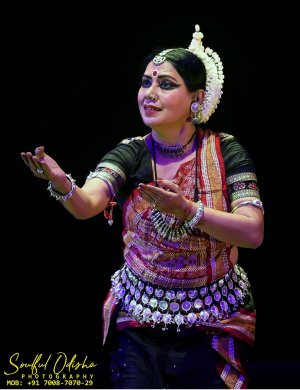 Aruna Mohanty Aruna Mohanty and her group from Orissa Academy comprised another extremely well organised group - the blend of abhinaya with pure dance moments in every item, adding up to a varied programme. Sansaar built round man's acceptance of life's progression from childhood, to middle age and on to old age, wonders why the inevitability of death as a natural closure is so feared. Likening life to a drop of water on a lotus leaf, the research by Kedar Mishra, with the Sanskrit sahitya vetted by scholar Nityananda Misra, along with the dance choreography by Aruna, in telling movement images, caught every stage of life. The final philosophical statement was based on Sankaracharya's poem "Bhaja govindam moodhamate". Changing in a trice from one stage of life to another the group images constantly moving were rendered in perfect coordination. The next item "E nadare mohita mu" (lost in the magic of sound) is built round 'Nada' (sound), which heralds the start of the Universe. The magic of sound finally takes the form of Krishna's divine flute music "Ki naado prana sangini subuchi kadamba bane" thinking of the ecstasy of the sounds of music emerging from the Kadamba orchard. This was a blend of Kedar Mishra's script with the transforming quality of music composed by Gopalchandra Panda, along with joyful pure dance rendered to the bols "Aja, tarejena -Takadam tarita". With extremely well trained students, Aruna's choreography uses group images, levels, and the entire space of the stage very well. The last item Naari Nirbhaya took the form of Sita narrating her life of suffering along with that of Draupadi in the Mahabharata, with the belief that constant trials have transformed womanhood from lajja roopena to shakti roopena where she becomes vengeful, with the courage to demand justice for herself. The production had Ramesh Chandra Jena's music with Dhaneswar Swain's mardal support. One must commend the organisers for projecting Marga Natyam, a reconstructed version of Bharata Muni's concept of dance, based on Piyal Bhattacharya's intense research, for 18 painstaking years, into the Natya Sastra. The Chitra Poorva Ranga wherein the Angika, as visualised in the reconstruction by Piyal Bhattacharya, with the music through ancient instruments like the conch shell, Taal marked with large cymbals, Harp like curved string instrument, the Mattakokila Veena, takes you to a different world. And the dance with the sukha lasya and hip swirl (so common to Padma Subrahmanyam's Bharata Nrityam) natural and without a trace of the consciously sensuous, along with the sheer delight of dialogue in the most lucid Sanskrit spoken by the characters, added up to a unique experience. The dancing quality had greater polish than what this critic saw last and the costume designing has undergone changes with greater sophistication in the old-timer design. Meticulously rehearsed, the performance was an eye opener for the audience, who need to be informed about how dance evolved in India. Altogether an excellently devised effort. Sattriya by Anita Sharma and her ensemble made another impressive group. Starting with Krishna Vandana predominating with hand gestures and facial expressions and Shankardev's slokas, set to Poditaal and Ektaal with music by Bhasker Ojha, the presentation went on to the lasya oriented Chali Naach with Ramdhani, Gitor Nach (with the word text) followed by Mela Naach in Soota and Ektaal. The music had melodious flute and bols recited to the percussion of the Khol. Lila Purushottam dilating on Krishna's childhood feats comprising the episode of Putana's killing and destruction of Bakasura with Guru Jatin Goswami's imaginative choreography, was another neat offering. Instead of the usual blend of dance traditions that Maitreyi Pahari is known to delight in, this presentation of her group doing pure Kathak was equally, if not more proficient. Dancing to the music composed by Sharat Chandra Srivastava, pinning the entire Kathak nritta and abhinaya around the theme of Devi was a good idea - for in the general refrain of Yadevi sarva bhuteshu, the shakti roopa, raudra roopa and shanti roopa came out with equal dignity, with the dancers combining flawlessly. Devi as Mother incorporating the five elements while searched everywhere, actually exists and has her root within one's consciousness. She is the Ardhangi and the Jagatjanani. Incorporating Kavits, with Devi incantation rendered to the aural rhythm of claps followed by fleeting images from Daksha's Yagna, ending with Devi as Maharaudri and Raktabeejanashini, finally ending with a Tarana, the entire group presentation from start to finish was woven round the Devi concept - and the dancing with flawless ang, had dancers aesthetically turned out in blue ghagras with choli in red and blue and dupatta in red. The Manipuri group from the Jawaharlal Nehru Manipur Dance Academy known all over the world for proficiency, presented Pung Cholom and Dhol Cholom drum dances - with all the rhythmic richness, where in the first, with dancing and playing simultaneously on the instrument, Manipuris worship, was followed by the skilful playing on the Dhol with acrobatic circling around the instrument, was rounded off with the absolute benign grace of Manipuri Raas, where on a full moon night of Basant Panchami, Krishna joins Radha and the Gopis in a dance. Gorgeous costumes in the best of aesthetics, along with deep devotion of bhakti sringar so special to the Manipuri tradition, were there for all to see and experience. Graceful Mohiniattam by Bharati Shivaji and her students commenced with the Gita Govind ashtapadi "Chandana charchita" with the music sung in Sopanam style, this particular lyric of Jayadeva describing Krishna sporting with the Gopis (aneka nari), particularly lending itself to group performance. Then came the popular Pandaattam, built round ball play, the up and down movements of the ball a metaphor for life itself with its vicissitudes. Purnima Ashok's Bharatanatyam presentation along with two students began on a neatly executed, promising note with the story of the birth of Natya, based on verses wherein Brahma taking aspects from each of the Vedas, creates the fifth Veda of Natya, evoking "Prema, Bhakti and Mukti" - with the performance designed to stress each of these aspects. The prema or sringar part, was built round the episode, when Rama for the first time chances upon the beauteous Sita playing with her companions and his eyes are rivetted to this "Gauri sarva sundari" (beauty incomparable). The line "Kankana kinkini noopura dhwani suni, Kahat Lakshmana suna Ram hridayaguni" with the accidental face-to-face of Ram and Sita looking at each other, was, though a fleeting moment, tellingly captured. The next item however, dilating on bhakti evoked through the dance of Shiva "Shambo Bho Shambho, was tepid, choreography and rendition needing more power. The finale of 'Mukti' based on three Meera bhajans strung together, with Purnima as a solo dancer moving round the vast stage, with only expression to hold the audience, became self indulgent, for one dancer doing abhinaya on that vast space, for so long, got lost. DUETS The duets for the festival seemed to reveal a fondness for presenting two traditions in interaction - not always a great idea when it necessitates constant accommodation between two styles of body movement- the adjustment, at times coming in the way of either dance getting the opportunity of flowering out fully. With the Sattriya/Kathak duet by Meernanda Borthakur (Sattriya) and Aligunjan Kalita and Chandrani Kalita Ojha (Kathak), only the first and last items accommodated both styles, with the rest of the presentation in one form. The Trideva Vandana invocation paying homage to Brahma, Vishnu and Shiva largely comprised frozen stances with three dancers posing at different levels for the Vande Deva Umapatim line with the concluding mention of Jagat kaaranam seeing the Sattriya dancer flanked by the two Kathak dancers. Kathak by Aligunjan and Chandrani Kalita in Vilambit teental with some graceful Thaat expressions and other nritta ingredients, followed by the very graceful Rajagudiya Chali in Sattriya by Meernanda Borthakur took a large part of the time for the recital. The last item, a Jugalbandi with both dance forms, choreographed by Meernanda, presented a brief rhythmic expression in tisra, chatusra and misra combinations. The choreography managed however, with a measure of intelligence, the two items taking on two dissimilar styles in one frame. Sulagna Banerjee and Rajdeep Banerjee presented a Kathak/Bharatanatyam duet. The opening Sutra, kavit and Sloka Champeya Gauranga with music set to ragas Bhopali, Kalavati, Jog, visualising Shiva/Parvati in one frame, with their differences (like his flying matted locks to her dhammila hairdo, forehead dotted with his third eye to hers with the vermilion mark, her flower garland to his rundamala etc) the two contrasts complementing in the single entity as Ardhaangapati, was very suited to the twin styles. But thereafter came Sulagna's solo Kathak in Taal Dhammar with the traditional Thaat, 'Samparane ka andaaj" , Amad, Paran along with a Bedam offering, gat nikas and a thumri "Arey Sakhi more piya ghar aave" and then solo Bharatanatyam by Rajdeep presenting Pushpanjali and finally a Tarana in Kalavati, which had Banerjee trying to do Bharatanatyam to Kathak mnemonics - which looked odd. Duets in the same style saw the two Kathak brothers Saurav and Gaurav Mishra (with an entire musical brigade comprising Mishras) presenting Benares gharana, with the usual 'dhamaka' Kathak - the pirouetting on one foot, the fast chakkars in teentaal with the sudden stop on the sam with the dancer ending in a squatting position on the floor, and the general zest of performance - though on occasion the sudden halt in freezes, found balance lacking. The varying accents in footwork, delicate ghungroo work evoking the feel of drizzling rain, and the inevitable "Bhola prem naganame nache" so special to Benares were all presented. Vinod Kevin Bachan and Vrinda Chadha, both under the guidance of Odissi dancer Ranjana Gauhar, began with a prayer 'Namah Shivaya', the well held stances for divyambaraya and digambaraya making for a graceful, still image. Pallavi in Raag Bhairav (musical composition by Saroj Mahanti), in ektali, choreographed by Ranjana with Dashavatar in taal Jhumpa, choreographed by Mayadhar Raut, concluded the recital. Mardal support had Praful Mangaraj and on the flute was Parashu Ram Das. 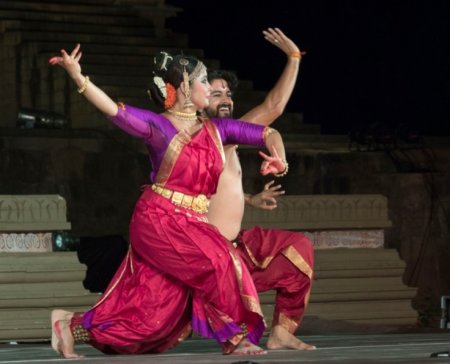 Ayana Mukherjee & Prashant Kalia The dynamic duet which held audience attention fully comprised a blend of Kuchipudi and Mayurbhanj Chhau - dancers being Ayana Mukherjee, a student of Jaya Rama Rao and Vanashree Rao and Prashant Kalia, a Mayurbhanj Chhau shishya of Santosh Nair of Sadhya. From the Ardhanarishwar start on to Mahadeva Shiva Shambho in raga Revati, dilating on the Markandeya episode to the finale of Tillana in Sindhubhairavi (music composed by Venkateshwaran) the two very varying body languages depicting male and female energies, one replete with grace and the other with power, blended excellently because of the clever choreography by Vanashree Rao, whose work lately, specialises in putting several dance forms in interaction. Upcoming dancer Ayana's grace and very expressive dance along with Prashant Kalia's excellent balance in holding a sheershasan pose and the one legged stances (though he has to work on the Chhau torso more) along with flair for abhinaya made for anarresting combination. The Meera bhajan "Barase badariya saavan ki" in Megh Malhaar, choreographed by Vanashree and rendered solo by Ayana saw all the involvement along with flowing Kuchipudi movement. With Venkateshwar's vocal support, Dr. S Vasudevan for nattuvangam and Kesavan on mridangam, the musical support lacked for nothing. SOLO PRESENTATIONS Among soloists, Deepak Maharaj's Kathak appeared scattered, showing the dancer not looking comfortable on the large stage, with the audience at a distance and in the dark. That his forte is footwork is known. After the Shiva homage, while teental had all the ingredients of Thaat, Uthan, Paran, tihai with mukhda in a different rhythmic touch, Parmelu et al, the dancer, constantly mentioning being Pt Birju Maharaj's son and disciple distracted, for this fact well known and mentioned in his introductory words, hardly needed repetition. And as the fortunate heir of a master, it is taken for granted that his dance will carry the father/Guru's touch. But when he presented "makhan chor" as gat bhav with the prelude remark of trying to "copy Maharaji" it struck one as odd - for while his Guru haddiscovered and brought out the dance in him, it was now up to the student to find himself in the dance. 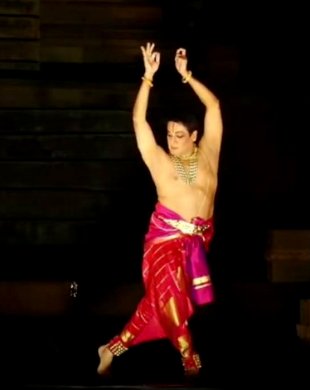 Sathyanarayana Raju Sathyanarayana Raju's clean Bharatanatyam began with the homage to Nataraja in "Devadi Deva" in raga Shanmukhapriya, choreographed by his Guru late Narmada. He was able to evoke the right measure of bhakti in lines like "Girija Ramanane vaa, vinaigal neeki arula vaa" (come, remove my troubles and bless me). 'Have you forgotten me, oh Lord?' asks the devotee. Purandhara Vithala's "Hanumantane Deva Namaha" set to raga Pantuvarali, in a concise rendition, through Raju's danced attitudes, caught the persona of Hanuman tellingly. He ended with a Tillana in Sumanasaranjini. Able to watch only a fraction of Dr. Ayswaria Wariar's Mohiniattam solo, while the concept of Shiva/Shakti was elaborated in the dance, the little one saw, suggested a neat dancer. The music with Shivprasad providing vocal support with mridangam, veena and edakka by Ramamurti Kesavan, Shyamala Bhaskaran and Satish Poduval respectively, gave strong support. The Odissi solos fell below expectations. The senior dancer Purnashree Raut chose two of the most erotic compositions from the Gita Govind for presentation. The first "Sakhi he keshi mathana mudaram" wherein Radha in a passionate appeal to the sakhi desires that she immediately fetch the 'killer of Keshi' to her - confiding in the sakhi her overpowering love as abhisarika, making her brave the dangers of the forest at night to meet her lover, remembering the passion of the first union with Krishna (Prathama Samagam). The second ashtapadi "Kuru yadu nandana" has the love-slaked Radha after having become one with Krishna, tenderly asking that he remove the dishevelment on her person, after a night of love (metaphorically asking back for her individuality dissolved in the union with Krishna - so that the entire lila of seeking Krishna and uniting with him, may start all over again). The dancer's abhinaya for these lyrics called for a total forgetfulness of the individual persona, along with an unselfconsciousness, involving merging of oneself with the subject - all of which, a tall order, were missing in the tepid generalised smiling treatment. In the case of the young Odissi dancer Arya Nande, a student of Guru Gajendra Panda, who presented a suite of items including Mangalacharan, Pallavi and finally Navarasa as choreographed by late Debaprasad Das, with all the nine states of being or rasas built round episodes from the Ramayana),the advantage of a fetching stage presence with some talent however needs more finish and polish in the dance. A solo in such a festival seemed premature. 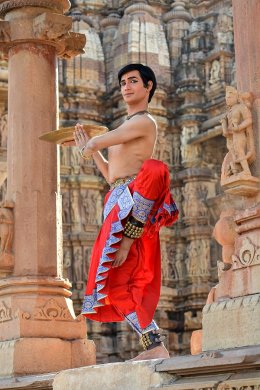 Avijit Das Avijit Das' vibrant Kuchipudi with prowess both in rhythmic and expressional dance spoke of this youngster meriting more chances. There is a Bharatanatyam flavour to his dance, perhaps from an earlier influence, but his Kuchipudi technique, even without too much of the swaying torso and up and down 'ubukku' is good and one admired his lively coverage of stage space. From the Kuchipudi Art Academy where he learnt from Sreemayi and Vedantam Ramu, and later from acharya Kishore Mosalikanti before settling down in Bangalore, his starting item for this programme was built round a Telugu translation of text from the Natya Sastra by Venkatamurty, the dance paying salutations to the great dancer Shiva. Avijit was also inspired by the Kandariya Mahadev temple in M.P, Vastadesha, where Shiva is worshipped in abstract as linga. The slokam used for the dance, translated by Arjun Bharadwaj, describes the architecture, the starting point of the dance with the right cardinal stance and way of holding the body in the saushtavam, followed by Bhoomi Pranam followed by some Karanas. The dancer ended with an Annamacharya composition set to music by Voleti Venkateshwarulu in ragamValaji set to adi talam "Kandarpa Janaka Garuda gamana Nandagopatmaja Namo Namo" on Lord Venkateshwara, the composition touching upon various manifestations of the lord - the avatars of Vamana and Narasimha and of Krishna sparing the life of serpent Kalinga in answer to the plea for mercy by his many wives. Raghuram's vocal support with Vinay Nagarajan on mridangam and Raghunandan on the flute provided the musical accompaniment for the dance. Another promising young soloist who presented Raigarh Gharana Kathak was Dr. Priya Srinivas, student of Jyoti Bakshi, ex-Director of Kairagarh University. The technical part confined itself to items from this gharana, the well turned out dancer's crisp ang and footwork with Padhant by Poonam Sarpe and tabla by Ramachandra Sarpe as accompaniment providing fine Kathak nritta knit into the nagma provided on Salman Khan's sarangi. The bandish in five gatis 3,4,5,7 and 9, Amad ,Tihai, the sudden stops on sam, Gat nikas and the Pakshi Paran with rain, thunder and the dancing peacock were all of a piece. Her recital concluded with a Raja Chakradhar Thumri "Gori salone tore nain" showing, with delicate abhinaya, the vasakasajja decorating herself. A marathon projection with three performances each day could have been restricted to two artistes per evening of proven proficiency.  Writing on the dance scene for the last forty years, Leela Venkataraman's incisive comments on performances of all dance forms, participation in dance discussions both in India and abroad, and as a regular contributor to Hindu Friday Review, journals like Sruti and Nartanam, makes her voice respected for its balanced critiquing. She is the author of several books like Indian Classical dance: Tradition in Transition, Classical Dance in India and Indian Classical dance: The Renaissance and Beyond. Post your comments Pl provide your name and email id along with your comment. All appropriate comments posted with name and email id in the blog will also be featured in the site. |